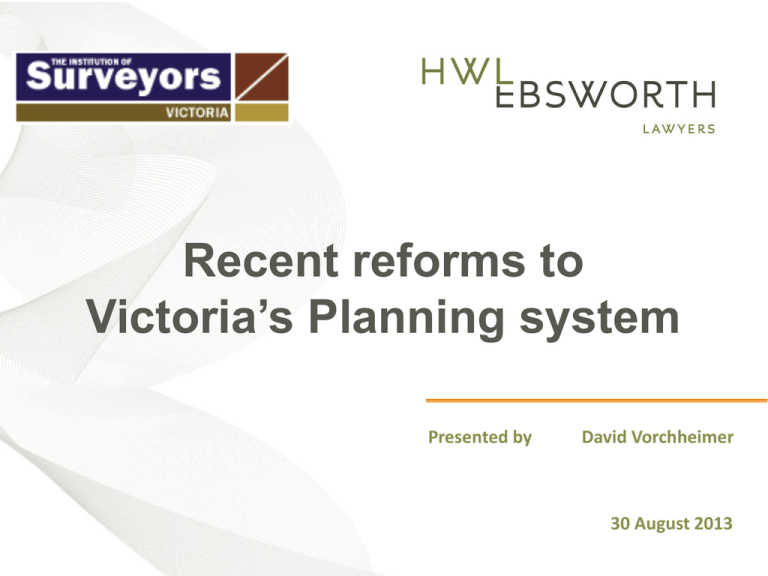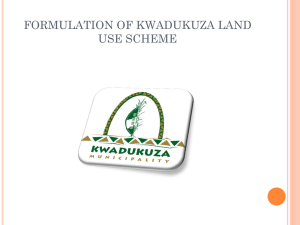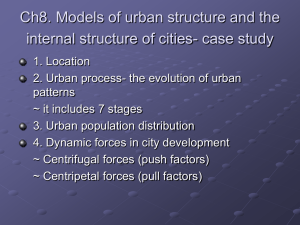
Recent reforms to
Victoria’s Planning system
Presented by
David Vorchheimer
30 August 2013
What we are covering
New Residential zones
Reformed Residential zones
New Commercial zones
Reformed Industrial zones
Changes to the Planning and Environment Act 1987
Background
Planning Schemes:
set out objectives, policies and provisions in relation to the use,
development and protection of land within an area.
have a single format across Victoria
are made up of:
State and local planning policies
Zone controls;
Overlay controls;
Particular provisions; and
General provisions.
Background
Zones set out the purpose and permit requirements for an area
(e.g. residential, business, industrial)
Overlay controls deal with specific requirements across zones / areas
(e.g. heritage, vegetation protection, significant landscapes, coastal
protection)
The changes only relate to zone controls.
Zone reforms - Overview
Announced on 11 July 2012
Changes are to affect all planning schemes across Victoria.
Proposed changes to residential, commercial and rural zones.
Residential zone changes announced on 5 March 2013;
Commercial and Industrial zones announced on 6 May 2013;
Rural zone changes were announced on 15 August 2013 and come into
effect on 5 September 2013;
Implementation of the new Residential Zones commenced on 1 July 2013
and will be completed over a 12 month period, with DPCD providing
assistance to Council's in the implementation; and
Implementation of the new Commercial and Industrial zones occurred on
15 July 2013. Potential adjustments to application of zones likely to occur
over time.
Overview
The changes encompass
Deletion of 9
existing zones
Creation of 5 new
zones
Amendment of 12
existing zones
Residential 1 Zone
Residential 2 Zone
Residential 3 Zone
Business 1 Zone
Business 2 Zone
Business 3 Zone
Business 4 Zone
Business 5 Zone
Priority Development
Zone
Residential Growth Zone
General Residential Zone
Neighbourhood
Residential Zone
Commercial 1 Zone
Commercial 2 Zone
Low Density Residential
Zone
Mixed Use Zone
Township Zone
Rural Living Zone
Green Wedge Zone
Green Wedge A Zone
Rural Conservation Zone
Farming Zone
Rural Activity Zone
Industrial 1 Zone
Industrial 2 Zone
Industrial 3 Zone
Residential Zones
Aim of Residential zone reforms
better manage growth and protect and maintain liveability and
neighbourhood character.
simplify requirements with greater certainty and clearer rules
allow a broader range of activities to be considered
2
Residential zones
The existing residential zones (Residential 1, 2 and 3) have been replaced
with new Residential Zones (Neighbourhood Residential Zone (NRZ),
General Residential Zone (GRZ) and Residential Growth Zone (RGZ)).
The existing Low Density Residential, Mixed Use and Township zones have
been amended.
The three new residential zones provide for varying levels and intensities
of residential development.
The Residential zone reforms
3
Key features
The purpose of each new zone clearly defines the zone.
Multiple schedules allowed in each zone.
A maximum building height of a dwelling or residential building can be specified
via a schedule (except for the LDRZ).
The operation of the ResCode provisions is maintained (except in the LDRZ), with
additional amenity provisions included in the RGZ and MUZ to land abutting other
residential zones.
Nine residential siting and amenity standards can be varied via the schedule to
the zone (except for the LDRZ).
A planning permit threshold of 300m2 to construct or extend one dwelling on a lot
or as increased via a schedule where allowed (except for the LDRZ).
Application requirements, decision guidelines and other requirements can be
specified via a schedule (except for the LDRZ).
Third party notice, objection and review rights in all zones for section 2 uses and
buildings and works applications associated with a section 2 use.
5
Key features
Less restrictions on non-residential land uses in the RGZ and MUZ (for
food and drink premises, medical centre, office, place of worship, and
shop).
Uses either prohibited or additional conditions included against uses in
the GRZ and NRZ for convenience restaurant, food and drink premises,
medical centre, office, place of worship, retail premises (including shop)
and take away food premises.
Bed and breakfast allows for 10 persons as of right in all zones.
In the LDRZ the default minimum lot size for subdivision of land
connected to reticulated sewerage has been decreased to 0.2 hectares.
Existing schedules to the LDRZ will continue to operate.
Objectives can be specified in a schedule to the MUZ to facilitate the use,
development and redevelopment of land.
Existing schedules to the MUZ and TZ will be translated to the new
6
schedules.
Residential Growth Zone
To provide housing at increased densities in buildings up to and including
four storey buildings.
To encourage a diversity of housing types in locations offering good
access to services and transport including activities areas.
To encourage a scale of development that provides a transition between
areas of more intensive use and development and areas of restricted
housing growth.
To allow educational, recreational, religious, community and a limited
range of other non-residential uses to serve local community needs in
appropriate locations.
The zone includes a discretionary default height limit of 13.5 metres which
can be increased or decreased via a schedule for a mandatory height limit.
7
General Residential Zone
To encourage development that respects the neighbourhood character of
the area.
To implement neighbourhood character policy and adopted
neighbourhood character guidelines.
To provide a diversity of housing types and moderate housing growth in
locations offering good access to services and transport.
To allow educational, recreational, religious, community and a limited
range of other non-residential uses to serve local community needs in
appropriate locations.
The zone does not include a default height limit but can stipulate a
mandatory height via schedule.
8
Neighbourhood Residential Zone
To recognise areas of predominantly single and double storey residential
development.
To limit opportunities for increased residential development.
To manage and ensure that development respects the identified neighbourhood
character, heritage, environmental or landscape characteristics.
To implement neighbourhood character policy and adopted neighbourhood
character guidelines.
To allow educational, recreational, religious, community and a limited range of
other non-residential uses to serve local community needs in appropriate locations.
The zone includes a default mandatory maximum height of 8 metres which via a
schedule can include a higher or lower mandatory height limit.
No more than 2 dwellings are allowed on a lot unless a schedule specifies a higher or
lower maximum number of dwellings.
9
Implementation of new residential zones
Councils are now going through a process of considering where the new zones are
to be applied, having regard to existing strategic work, such as local housing
strategies.
Councils are at varying stages in this process:
Implemented (Glen Eira City Council – 23 August 2013);
Councils with adopted housing strategies;
Councils with housing strategies being developed; and
Council with no housing strategy underway or proposed.
11
Implementation of new residential zones
Cannot translate all existing residential zones to new residential zones
Planning scheme amendments will need to be initiated by Councils to effect change
The three new residential zones were implemented into the VPP through a statewide amendment and Ministerial Direction changes by 1 July 2013.
On 1 July 2013, the amended Mixed Use Zone, Township Zone and Low Density
Residential Zone were incorporated into the VPP and individual planning schemes
through Amendment V8 with existing schedules updated/amended (MUZ and TZ
schedules are amended, LDRZ schedule remains as existing).
As on 1 July 2013, Councils can now initiate amendments, utilising the package of
new residential zones for their municipality. The existing R1Z, R2Z and R3Z can no
longer be used for amendments.
12
Zone selection principles
New Residential Zone
Purpose
RGZ
GRZ
NRZ
Possible principles in applying zones
Some principles can be deduced from the purposes
of the zones (and should be considered together)
Likely application
Enables new housing
growth and diversity in
appropriate locations
In appropriate locations near
activity areas, train stations
and other areas suitable for
increased housing activity
Respects and preserves
neighbourhood character
while allowing moderate
housing growth and
diversity
In most residential areas where
moderate growth and diversity
of housing that it is consistent
with existing neighbourhood
character is to be provided
Restricts housing growth
in areas identified for
urban preservation
In areas where single dwellings
prevail and change is not
identified, such as areas of
recognised neighbourhood
character, environmental or
landscape significance
Locations offering good access to services, transport
and other infrastructure
Areas which provide a transition between areas of more
intensive use and development and areas of restricted
housing growth
Areas with a diversity of housing stock, diversity of larger
lots sizes and a more varied and eclectic neighbourhood
character
Areas where modest housing growth and housing
diversity is encouraged
Areas with a neighbourhood character that is sought to
be retained
Areas with Neighbourhood Character Overlays
Residential areas with Heritage Overlays (such as larger
heritage precincts, rather than individually recognised
heritage sites)
Areas of identified environmental or landscape
significance.
Areas which may not have good supporting transport
infrastructure or other infrastructure, facilities and services
and not likely to be improved in the medium to longer term
13
Zone selection criteria
Applicable to
Potential criteria
Neighbourhood
Residential
Zone (low levels
of residential
change)
General
Residential
Zone (minimal
to moderate
levels of
residential
change)
Residential
Growth Zone
(high levels of
residential
change)
Character
1
Neighbourhood character (evidence through
HO, NCO, DDO, significant intactness)
Yes
Yes
No
2
Emerging or preferred neighbourhood character
(evidence with DDO)
No
No
Yes
3
Existing Landscape Character (evidence
through SLO, ESO, Local Policy)
Yes
Yes
No
4
Risk associated with known hazard (evidenced
through BMO, LSIO or EMO for fire, flood and
landslip)
High
Low
Low
5
Level of development activity (existing and
desired)
Low
Low/moderate
High
6
Brownfield/urban renewal site/area
No
No
Yes
14
Zone selection criteria
Applicable to
Potential criteria
Neighbourhood
Residential
Zone (low levels
of residential
change)
General
Residential Zone
(minimal to
moderate levels
of residential
change)
Residential
Growth Zone
(high levels of
residential
change)
Strategic
7
Housing and Development Strategy
Yes
No
Yes
8
Identified in Activities Area structure plan/policy
No
No
Yes
9
Commercial or industrial land for redevelopment
not in Activities Area (strategic justification for
rezoning required)
No
Yes
Yes
10
Access to employment options
No
No
Yes
Context
11
Good access to local shopping
No
No
Yes
12
Good access to local community services
No
No
Yes
13
Good access to transport choices
No
No
Yes
15
1
1
1
Where zones will be applied
Housing Strategy
MSS review / update
local policies
Matrix
Identified character elements to preserve (HO, NCO etc.)
Significant landscape / environment elements
Poor access to transport, infrastructure, services
tricked up schedule to GRZ v NRZ
Schedules to GRZ – mandatory v discretionary elements
Transition
Changes to Clause 55 do not apply to:
an application to construct or extend a development of four or more
storeys made before the approval date of the planning scheme
amendment in relation to a particular planning scheme; and
an application under section 69 of the Act to extend a permit to construct
or extend a development of four or more storeys granted on or before
the approval date of Amendment VC100.
The limitation on number of dwellings and Maximum building height
provisions in the NRZ do not apply to applications made before the
approval date of the planning scheme amendment in relation to a particular
planning scheme.
Commercial and Industrial Zones
Aim of Commercial / Industrial zone reforms
provide greater flexibility and growth opportunities for Victoria’s
commercial and business centres, responding to changing retail,
commercial and housing markets by allowing for a wider range of uses
that will support more mixed use employment.
support business investment and industry by responding to new and
emerging trends regarding the mix of industry, office and some forms of
limited retail, and provide greater incentive for business investment.
2
3
Commercial zone reform
Under the reforms:
In metropolitan areas the C1Z and C2Z do not have schedules, and there
is no ability to set out different performance criteria;
The C1Z allows for accommodation, retail premises and office uses as of
right, with buildings and works, and subdivision exempt from notice and
appeal. No building heights are included in the C1Z; and
The C2Z allows for industry, warehouse and restricted retail uses as of
right, and does not include floor area restrictions for office.
Commercial 1 Zone
removes permit requirements for:
all Accommodation (other than a Corrective institution)
all retail uses (except for Adult sex bookshop)
Exhibition centre
remove the conditions for Education centre and Office
broadens the range of activities that land can be used for without the
need for a planning permit and generally removes floor area restrictions.
building and works and subdivisions continue to require a permit.
all floor space caps for shop and office have been removed for
Melbourne metropolitan Councils but rural Councils have had existing
schedules to the Business 1 and 2 zones migrated to a new Commercial 1
Zone schedule
4
Commercial 2 Zone
removes permit requirement for use for a Cinema, Cinema-based
entertainment facility, Food and drink premises, Office, Restricted retail
premises and Trade supplies;
prohibits accommodation (other than caretakers house, motel and
residential hotel;
allows use for a small-scale supermarket (<1800m2) and associated shops
(<500m2) without a permit in the Melbourne metropolitan area. Larger
supermarkets and stand alone shops require a permit in the Melbourne
metropolitan area (prohibited in rural municipalities);
building and works and subdivisions will continue to require a permit;
removes floor area restrictions for office and retail uses to create new
opportunities for office and retail growth; and
provide greater opportunity for office and employment uses including
commercial businesses, restricted retail premises, trade supplies and some
limited retailing activities.
5
Commercial zones
supermarket and shops permitted in C1Z without a permit;
small scale supermarket of up to 1800m2 permitted in C2Z without a permit
in all metropolitan planning schemes. Supermarkets greater than 1800m2 in
C2Z require a permit;
small scale supermarket of 1800m2 in C2Z in rural areas require a permit;
and
supermarkets and associated shops must adjoin or have access to a main
road in the C2Z.
removes restrictions on floor space caps in most instances in commercial
zones in metropolitan Melbourne and in rural Victoria for the C2Z;
allows floor space caps to be specified in rural and regional Victoria in the
schedule to the C1Z;
all accommodation as of right (provided ground floor frontage does not
exceed 2 metres) in C1Z; and
prohibits all accommodation (other than caretaker’s house, residential
6
motel and hotel) in C2Z.
7
Industrial zone reform
Under the announced reforms:
Office floor area limits are removed in the Industrial 1 and 2 zones;
Office floor area caps can be specified in the Industrial 3 zone and small
scale supermarkets (up to 1,800m2) with supporting shops are allowable
where adjoining or having access to a road in a Road Zone in Metropolitan
Melbourne;
In regional areas floor space caps can be applied through schedules to the
C1Z and C2Zs for shops and offices and a neutral translation of existing
floor space caps occurred on 15 July 2013; and
In regional areas floor space caps are maintained in the Industrial Zones.
Implementation zone changes – 15 July 2013
the existing five Business Zones and associated schedules have been deleted from the
VPP and individual planning schemes through Amendment VC100.
the new commercial zones have been inserted into the VPP and individual planning
schemes through Amendment VC100 with new schedules from the Business 1 and 2
zones amalgamated and inserted into individual rural planning schemes. Consultation
will occur with rural councils on the content of that schedule to resolve any
inconsistencies
the amended Industrial 1, Industrial 2 and Industrial 3 Zones have been incorporated
into the VPP and individual planning schemes through Amendment VC100 with
existing or new schedules updated and inserted or amended into individual planning
schemes.
10
Key issues – Commercial / Industrial Zones
No transition.
Has resulted in very large C1 areas where floor area caps have been
removed.
Removed transitions.
Removal of floor area caps in overlays and other controls (in Metropolitan
Melbourne) (31 December 2013).
Bleeding out of retail activity.
Inability to define activity areas.
Added pressure of VC88 (Restricted Retail Uses)
Key changes to the
Planning and Environment Act
Stage 1 changes
On the 22 July 2013 the first stage of the Planning and Environment
Amendment (General) Act 2013 (General Act) commenced.
Changes include:
abolishing Development Assessment Committees and establishing
Planning Application Committees;
setting out the duties of a referral authority;
making a referral authority, rather than the Responsible Authority, liable
for compensation in certain circumstances;
including referral authorities in the list of bodies that must act
expeditiously;
making various amendments to clarify the allocation of liability for
compensation arising from the reservation of land for a public purpose;
Stage 1 changes
amendments to allow a Responsible Authority to amend a permit issued
at the direction of the Victorian Civil and Administrative Tribunal (VCAT);
limiting the scope of VCAT to extend an expired permit;
allowing VCAT to limit its review of a matter to the specific issues in
dispute between the parties; and
alterations to the time for permit holders to request an extension of time
for an expired permit.
Amending Tribunal Issued Permits
A permit holder can now apply to Council to amend a permit that has been
issued at the direction of VCAT unless VCAT has specified that the permit may
only be amended by VCAT. Where a permit has been issued before 22 July
2013, the permit may be amended either by the Responsible Authority or
VCAT.
Extending expired permits
A permit holder can now request an extension of time:
before or within 6 months after the permit expiry date, where the use or
development has not yet started; and
within 12 months after the permit expiry date, where the development
has lawfully started before the permit expires.
The new times apply to all extension of time requests, not just those made on
or after 22 July 2013.
VCAT may limit review to issues in dispute
VCAT will now be able to confine a review to the particular matters in
dispute if all the parties to the review agree.
VCAT may interpret a section 173 agreement
VCAT now has jurisdiction to make a declaration relating to the
interpretation of a section 173 agreement.
Stage 2 changes
The remaining changes to the PE Act and the Subdivision Act under the
General Act will commence in Stage 2 which will commence on 28 October
2013.
Such changes include a clarification that Section 18 of the Subdivision Act
1988 does not apply if a requirement for Public Open Space is provided for in
the Planning Scheme.
Questions, Comments, Observations?
Further information - www.hwle.com.au
© HWL Ebsworth Lawyers
MARK BARTLEY Partner
P +61 3 8644 3712
E mbartley@hwle.com.au
DAVID VORCHHEIMER Partner
P +61 3 8644 3421
E dvorchheimer@hwle.com.au
INDRA SOYSA Senior
Associate
P +61 3 8644 3711
E isoysa@hwle.com.au
JAMES LOFTING Senior
Associate
P +61 3 8644 3414
E jlofting@hwle.com.au
hwlebsworth.com.au
Office Locations
Brisbane
Canberra
Melbourne
Norwest
Sydney
Level 23
Riverside Centre
123 Eagle Street
Brisbane QLD 4000
Level 1
25 National Circuit
Forrest ACT 2603
Level 26
530 Collins Street
Melbourne VIC 3000
Suite 310, Level 3
Norwest Central
12 Century Circuit
Baulkham Hills
NSW 2153
Level 14
Australia Square
264-278 George Street
Sydney NSW 2000
P +61 2 6151 2100
F 1300 769 828
P +61 3 8644 3500
F 1300 365 323
P +61 2 9334 8555
F 1300 369 656
P +61 2 9334 8555
F 1300 369 656
Level 2
500 Queen St
Brisbane QLD 4000
P +61 7 3002 6700
F 1300 368 717
© HWL Ebsworth Lawyers
hwlebsworth.com.au








